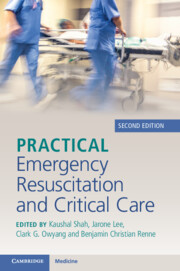Book contents
- Practical Emergency Resuscitation and Critical Care
- Practical Emergency Resuscitation and Critical Care
- Copyright page
- Contents
- Contributors
- Preface
- Section 1 General Critical Care
- Section 2 Infectious Disease Emergencies
- Section 3 Neurological Emergencies
- Section 4 Cardiovascular Emergencies
- Section 5 Respiratory Emergencies
- Section 6 Gastrointestinal Emergencies
- Section 7 Renal Emergencies
- Section 8 Hematology–Oncology Emergencies
- Section 9 Endocrine Emergencies
- Section 10 Environmental Emergencies
- Section 11 Trauma
- 47 General Trauma Principles
- 48 Severe Traumatic Brain Injury
- 49 Neck Trauma
- 50 Thoracic Trauma
- 51 Solid Organ Abdominal Trauma
- 52 Severe Pelvic Trauma
- 53 Soft Tissue Injury
- 54 Burn Resuscitation
- Section 12 End of Life
- Index
- References
48 - Severe Traumatic Brain Injury
from Section 11 - Trauma
Published online by Cambridge University Press: 02 November 2023
- Practical Emergency Resuscitation and Critical Care
- Practical Emergency Resuscitation and Critical Care
- Copyright page
- Contents
- Contributors
- Preface
- Section 1 General Critical Care
- Section 2 Infectious Disease Emergencies
- Section 3 Neurological Emergencies
- Section 4 Cardiovascular Emergencies
- Section 5 Respiratory Emergencies
- Section 6 Gastrointestinal Emergencies
- Section 7 Renal Emergencies
- Section 8 Hematology–Oncology Emergencies
- Section 9 Endocrine Emergencies
- Section 10 Environmental Emergencies
- Section 11 Trauma
- 47 General Trauma Principles
- 48 Severe Traumatic Brain Injury
- 49 Neck Trauma
- 50 Thoracic Trauma
- 51 Solid Organ Abdominal Trauma
- 52 Severe Pelvic Trauma
- 53 Soft Tissue Injury
- 54 Burn Resuscitation
- Section 12 End of Life
- Index
- References
Summary
Severe traumatic brain injury (TBI) is usually defined as a Glasgow Coma Scale (GCS) score < 9. The goals of early resuscitation should focus on identifying and treating the primary injuries and limiting the negative cascade of secondary injuries such as hypotension and hypoxia. All patients with suspected severe TBI need an emergent computed tomography (CT) scan of the brain to identify hemorrhage immediately following initial stabilization. Ten percent of severe TBI patients have concomitant c-spine injury.
Keywords
- Type
- Chapter
- Information
- Practical Emergency Resuscitation and Critical Care , pp. 516 - 527Publisher: Cambridge University PressPrint publication year: 2023

